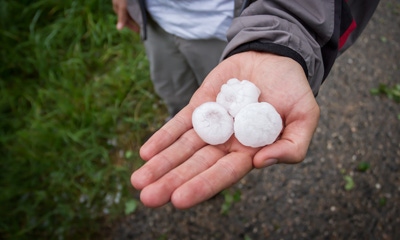
One of my most vivid memories of my teens is being in the old farmhouse with my mom during an early July thunderstorm, which roared in late one Sunday evening. Dad was a few miles away helping combine wheat.
The clouds closed in. Then the house got dark. Eventually the lights went out. Winds got so strong that the screen doors swung open and shut. Yes, I was scared. I was a "wimpy kid," at least when it came to storms.

SUMMERTIME NEMESIS: Anyone who has seen what hail can do to crops this time of year understands why hearing a forecast that it's coming might make a farmer nervous.
Suddenly, something was hitting the windows, making loud noises. It was hail — and the longer it went, the louder the noises got. That’s because the hail got bigger. Mom says it hailed for 45 minutes. Whether it really did or not, I don’t know. What I do know is that it seemed like hours.
When it ended, Mom grabbed a flashlight and made a beeline out the back door. Our neighbor walked over from across the road. Mom was headed to the garden.
“Oh, my beautiful tomatoes!” she exclaimed. “They’re ruined!”
“What about your corn and soybeans?” the neighbor asked, incredulous.
“Oh, I didn’t think about that,” Mom deadpanned.
Since then, I’ve had lots of questions about hail and other weather events. In this new feature, experts will try to answer questions many people ask but are seldom answered. W. Logan Downing, assistant in the Indiana State Climate Office, and Ken Scheeringa, associate state climatologist, offer this month’s answer.
Q: Most people believe hail only hits small areas with intensity — maybe a few fields. Why are intense hail events more localized, or is this simply a myth?
A: Many times hail will fall in a fairly large area. But the most severe hail does tend to be localized, affecting a small area with the most damage. The reason that intense hail tends to localize has to do with its formation.
Hailstones form as water droplets rise and fall above the freezing level in the updraft of thunderstorms. The largest hailstones tend to grow and congregate in the stronger center of the updraft, while the smaller, lighter hailstones are pushed out and away. This “sorting” process of the hailstones continues until they become too heavy and begin to fall out. At this point most of the large hailstones — baseball-size or larger — are confined to a very localized area, as shown in the diagram accompanying this story.
The National Weather Service issues a warning when hailstones of 1 inch or more in diameter are expected. After the storm, only hail reports meeting this warning criteria are published in Storm Data, based on all reports received. Insurance companies must be aware that just because a hail event isn’t listed in Storm Data doesn’t mean hail did not occur in a certain location on a given date.

HOW A HAILSTONE FORMS: Study this graphic carefully to see what is involved in a hailstone being formed during a storm. (Graphic provided by Indiana State Climate Office.)
About the Author(s)
You May Also Like




